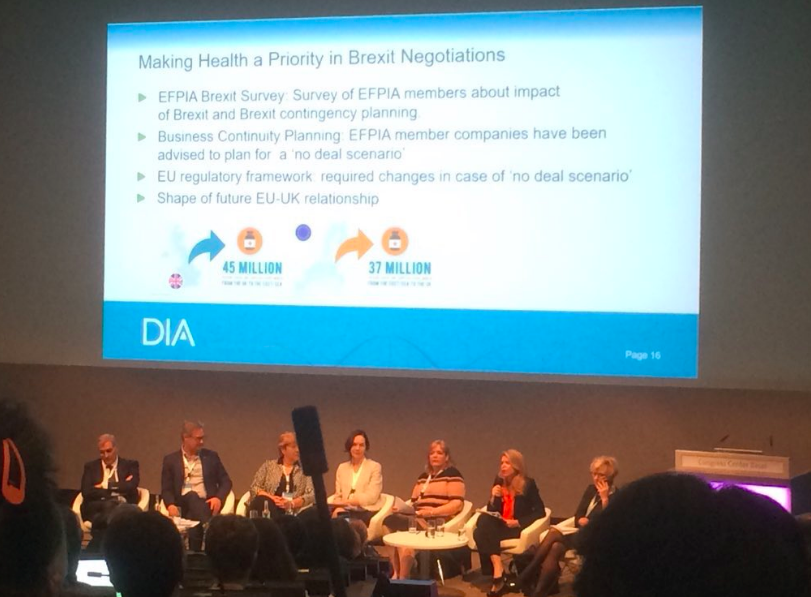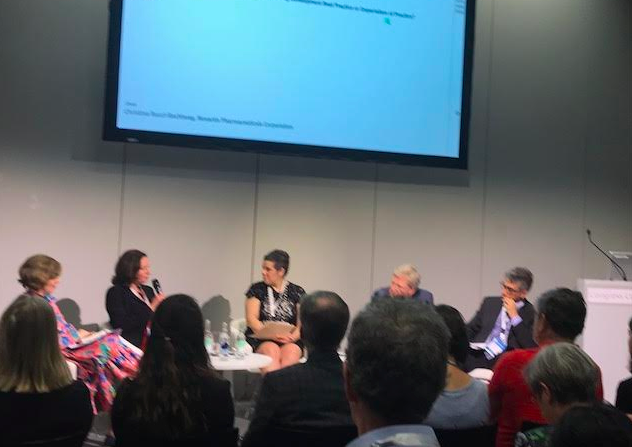From leaving the EU to joining the European Medicines Verification System
EFPIA reflections on DIA Europe, Basel, Switzerland, 16-19th April 2018
This year, the EFPIA team together with our colleagues from the European Biopharmaceutical Enterprises (EBE) prepared and participated in sessions close to our heart and of key importance to all our members. Let’s see what we learned and experienced!
After her participation in the Brexit panel, Nathalie Moll, Director General of EFPIA, said. “I found the debate encouraging as it showed that next to the plans that the different stakeholders are undertaking to tackle the challenges posed by Brexit, we are all (EMA, national authorities, patients and industry) working on the other pressing opportunities and challenges. Those are presented by the changing scientific and regulatory landscapes. It was good to hear that while managing Brexit, Agencies will all prioritise continued predictability and timeliness of assessments and authorisations of new treatments for the benefit of patients in this transition phase.”

Audrey Wolf, EBE Manager for Public Affairs was kept busy with the organisation of a joint EBE-EFPIA Personalised Medicines working group session on the In Vitro Diagnostics Regulation (IVDR). All stakeholders, including national competent authorities, notified bodies, pharma and diagnostic industries agreed on a huge amount of challenges paving the way until the implementation of the Regulation in 2022. The importance and willingness to collaborate together to ensure an optimal process for the benefit of the patient got highlighted.
Barbara Freischem, Executive Director of EBE shared her excitement of the opportunity to get EBE-EFPIA funded research presented at the congress. The Escher Advanced Therapy Medicinal Product (ATMP) study and the sneak preview on the CRA study on the economic benefit of the personalized medicines were well received. Barbara underlined the importance of one of the overarching themes of the conference, namely digitalization, saying that “Though it is clear that much remains to be done, there was a great sense of excitement about the new technologies and a willingness to collaborate to make sure the products reach patients. Digital technology will be the next big evolution, the magnitude of which George Savage, the key not speaker at DIA Europe 2018, likened to the revolution that biologic medicines brought.”

The EBE team also highlighted the session on precision medicine and personalised healthcare chaired by Marisa Papaluca-Amati from European Medicines Agency (EMA). She reiterated that the EMA is now collaborating with a broader range of stakeholders, including the HTA bodies, academics and patients. EMA’s advice and take-home message to the industry was to get involved earlier with the regulators so that they can act as catalysers and facilitate the discussion between the all stakeholders, including HTA bodies.

In order to address the remaining challenges, the next steps involve multi-stakeholder dialogue on the needs of children, analysing the use of deferrals, speedier completion and analysing the handling of of PIP/applications. If necessary, the guidelines should change. Strong voices were raised to provide additional transparency of new products authorised with paediatric indications, to deliver regular updates about development and trends of the paediatrics medicines and to foster international cooperation and harmonisation. Important timelines were pointed out as well. There are two years now to evaluate the situation, for example the study on orphans will be delivered in 2019 by the European Commission.
Sini Eskola, EFPIA’s Director Regulatory, Drug Development and Manufacturing was also concentrating on a few hot policy topics, primarily the upcoming Clinical Trials Regulation as well as the efforts made and challenges remaining in terms of increased clinical trial data transparency. Through the multi-stakeholder discussions throughout the conference it was felt that the “blame game” in this area has come to its end and the huge efforts in terms of culture change and financial contributions for the increased transparency, ultimately for the benefit of public health, get recognised. The regulators, academic and industry sponsors, patients, transparency advocates (NGOs) see the value in tackling the biggest issues of common interest together such as solving the question on how to secure the patient privacy while making the clinical data utility as high as possible for the data sets being shared. Industry presentations highlighted the already existing practices put in place through the EFPIA-PhRMA Principles of Responsible Clinical Data Sharing which could serve the model for others who have still not fully joined the efforts or for regulators who are looking into expanding the scope of transparency to include patient level data sharing.
While anticipating the EU strategy on pharmaceuticals in the environment (PIE) to be published in June by the European Commission, the representatives from German Environmental Agency (Ines Rönnefahrt) and representatives of the innovative industry (Bengt Mattson) and the European generics and biosimilars industry (Katarina Nedog) were brought together by EFPIA for an interactive panel discussion with a healthy dose of audience participation. One answer that got unanimous support from all was that the patients can play their role as well and we should do efforts in increased awareness of the correct use and disposal of medicines. The different perspectives on the need to protect environment while securing patient access to medicines were balanced between the views from environmental agency and industry.
